Quantifying predation pressure and the protective role of sheltered basking sites for small snakes in South Africa
DOI:
https://doi.org/10.11606/issn.2316-9079.v15i2p155-162Keywords:
clay snake models, snake attack risk, snake mortality, snake predationAbstract
Small snakes are frequent prey of predatory birds, reptiles, and mammals. The resulting mortality rate is difficult to quantify given the low likelihood of observing such predation events. However, studies using plasticine snake models have shown that small snakes may experience relatively high rates of predation. Model snakes constructed from slow-drying clay (as a substitute to plasticine) were used to assess the predation rate on small snakes in the Eastern Cape of South Africa. The model snakes were used to test whether snakes basking in semi-shaded positions, with at least half of the body covered by overhanging vegetation are detected by bird and mammal predators. There were relatively high rates of predation, with half of the unconcealed snake models experiencing attacks. The predation rate on partially concealed models is lower than on unconcealed models, but the difference is not statistically significant. Thus, basking in sheltered areas may offer snakes protection against predators; however, predation attempts on concealed models suggests that predators actively seek out areas where prey might hide. This is the first quantification of predation on small snakes in South Africa, and the results generate numerous questions relating to the behavioral ecology of the diverse snake fauna found in this countryDownloads
Download data is not yet available.
Downloads
Published
2016-12-22
Issue
Section
Articles
License
All material originally published in Phyllomedusa belongs to Escola Superior de Agricultura Luiz de Queiroz - Universidade de São Paulo. All contents are under a license of Creative Commons BY-NC-ND.How to Cite
Coombs, G. (2016). Quantifying predation pressure and the protective role of sheltered basking sites for small snakes in South Africa. Phyllomedusa: Journal of Herpetology, 15(2), 155-162. https://doi.org/10.11606/issn.2316-9079.v15i2p155-162



 Impact Factor (JCR): 0.600
Impact Factor (JCR): 0.600 CiteScore: 1.0
CiteScore: 1.0